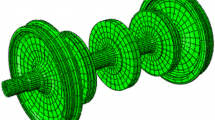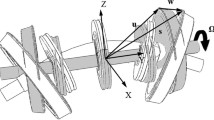Abstract
In predicting the track-ground vibrations induced by moving trains, it is generally assumed that the irregularities of two rails of a track are identical and fully correlated. This assumption leads to identical contact forces at the contact point of wheels and rails. In the present paper, the uncorrelated profile of the two rails is considered to investigate their influence on the train-track-ground vibrations. For this purpose, a three-dimensional (3D) finite element model capable of simulating interactions between a 3D train and track by using a nonlinear Hertz contact method is developed. Nonlinear Hertz contact is represented by the tensionless stiffness between the wheels and rails. The rails are modeled as 3D Euler–Bernoulli beam elements. Solid brick elements represent the model components, such as the track (other than rail) and ground. A detailed description of an iterative numerical algorithm is presented to establish the integrations of the train and track system. This iterative numerical algorithm can calculate the responses and forces at the interaction point between each wheel and rail to incorporate the uncorrelated profile of two rails, instead of only considering the interaction at the centroid of the wheelset axle and the center of the track. A comparative study is conducted by considering various train speeds and three different track cases. The results show that an increase in train speed causes an increase in ground vibration in the case of uncorrelated profiles of two rails of a track. Moreover, the effects of correlated and uncorrelated profiles of two rails of a track are investigated in terms of the train-track-ground responses.


















Similar content being viewed by others
References
Abu-Farsakh, M., Ardah, A., & Voyiadjis, G. (2018). 3D Finite element analysis of the geosynthetic reinforced soil-integrated bridge system (GRS-IBS) under different loading conditions. Transportation Geotechnics, 15, 70–83.
Antolín, P., Zhang, N., Goicolea, J. M., Xia, H., Astiz, M. Á., & Oliva, J. (2013). Consideration of nonlinear wheel–rail contact forces for dynamic vehicle–bridge interaction in high-speed railways. Journal of Sound and Vibration, 332(5), 1231–1251.
Auersch, L., & Said, S. (2017). Track-soil dynamics–calculation and measurement of damaged and repaired slab tracks. Transportation Geotechnics, 12, 1–14.
Bachmann, H., Pretlove, A., & Rainer, H. (1995). Human response to vibrations vibration problems in structures practical guidelines. Basel: Birkhäuser.
Cao, S., Yang, R., Shi, L., Li, J., & Liu, X. (2019). Distribution characteristic of hydrodynamic pressure in the ballastless track crack under the train load. KSCE Journal of Civil Engineering, 23(2), 576–586.
Celebi, E., & Schmid, G. (2005). Investigation of ground vibrations induced by moving loads. Engineering Structures, 27(14), 1981–1998.
Chopra, A. K. (2012). Dynamics of structures. Upper Saddle River: Pearson Education.
Connolly, D., Giannopoulos, A., & Forde, M. C. (2013). Numerical modelling of ground borne vibrations from high speed rail lines on embankments. Soil Dynamics and Earthquake Engineering, 46, 13–19.
Corbin, J. (1980). Statistical representations of track geometry: Volume I. Technical reports. U.S Department of Transportation Federal Railroad Administration Office of Research and Development. https://railroads.dot.gov/sites/fra.dot.gov/files/fra_net/15245/Statistical_Rep_Track_Geometry_Vol1.pdf. Accessed 01 August, 2020.
El Kacimi, A., Woodward, P. K., Laghrouche, O., & Medero, G. (2013). Time domain 3D finite element modelling of train-induced vibration at high speed. Computers and Structures, 118, 66–73.
Galvín, P., François, S., Schevenels, M., Bongini, E., Degrande, G., & Lombaert, G. (2010). A 2.5D coupled FE-BE model for the prediction of railway induced vibrations. Soil Dynamics and Earthquake Engineering, 30(12), 1500–1512.
Hussein, M. F. M., & Hunt, H. E. M. (2009). A numerical model for calculating vibration due to a harmonic moving load on a floating-slab track with discontinuous slabs in an underground railway tunnel. Journal of Sound and Vibration, 321(1), 363–374.
Kouroussis, G., Connolly, D. P., & Verlinden, O. (2014). Railway-induced ground vibrations–a review of vehicle effects. International Journal of Rail Transportation, 2(2), 69–110.
Kouroussis, G., Verlinden, O., & Conti, C. (2012). A two-step time simulation of ground vibrations induced by the railway traffic. Proceedings of the Institution of Mechanical Engineers, Part C: Journal of Mechanical Engineering Science, 226(2), 454–472.
Krylov, V. V. (1995). Generation of ground vibrations by superfast trains. Applied Acoustics, 44(2), 149–164.
Lei, X., & Noda, N.-A. (2002). Analyses of dynamic response of vehicle and track coupling system with random irregularity of track vertical profile. Journal of Sound and Vibration, 258(1), 147–165.
Lysmer, J., & Kuhlemeyer, R. L. (1969). Finite dynamic model for infinite media. Journal of the engineering mechanics division, 95(4), 859–878.
Mezher, S. B., Connolly, D. P., Woodward, P. K., Laghrouche, O., Pombo, J., & Costa, P. A. (2016). Railway critical velocity–analytical prediction and analysis. Transportation Geotechnics, 6, 84–96.
Mu, D., & Choi, D.-H. (2014). Dynamic responses of a continuous beam railway bridge under moving high speed train with random track irregularity. International Journal of Steel Structures, 14(4), 797–810.
Mu, D., Gwon, S.-G., & Choi, D.-H. (2016). Dynamic responses of a cable-stayed bridge under a high speed train with random track irregularities and a vertical seismic load. International Journal of Steel Structures, 16(4), 1339–1354.
Nguyen, V. D., Kim, K. D., & Warnitchai, P. (2009). Dynamic analysis of three-dimensional bridge–high-speed train interactions using a wheel–rail contact model. Engineering Structures, 31(12), 3090–3106.
Ntotsios, E., Thompson, D., & Hussein, M. (2017). The effect of track load correlation on ground-borne vibration from railways. Journal of Sound and Vibration. https://doi.org/10.1016/j.jsv.2017.05.006.
Ntotsios, E., Thompson, D. J., & Hussein, M. F. M. (2019). A comparison of ground vibration due to ballasted and slab tracks. Transportation Geotechnics. https://doi.org/10.1016/j.trgeo.2019.100256.
Phillips, C., & Hashash, Y. M. (2009). Damping formulation for nonlinear 1D site response analyses. Soil Dynamics and Earthquake Engineering, 29(7), 1143–1158.
Ranjan, G., & Rao, A. (2007). Basic and applied soil mechanics. New Delhi: New Age International.
Real, T., Zamorano, C., Hernández, C., García, J., & Real, J. (2016). Static and dynamic behavior of transitions between different railway track typologies. KSCE Journal of Civil Engineering, 20(4), 1356–1364.
Shabana, A. A., Zaazaa, K. E., & Sugiyama, H. (2007). Railroad vehicle dynamics: A computational approach. London: CRC Press.
Shahbaznia, M., Mirzaee, A., & Dehkordi, M. R. (2020). A new model updating procedure for reliability-based damage and load identification of railway bridges. KSCE Journal of Civil Engineering, 24(3), 890–901.
Sheng, X., Jones, C., & Thompson, D. (2004). A theoretical model for ground vibration from trains generated by vertical track irregularities. Journal of Sound and Vibration, 272(3–5), 937–965.
Thompson, D. (2008). Railway noise and vibration: mechanisms, modelling and means of control. Amsterdam: Elsevier.
Xia, H., Zhang, N., & Guo, W. (2018). Dynamic interaction of train-bridge systems in high-speed railways. Beijing: Beijing Jiaotong University Press and Springer GmbH Germany.
Zhai, W., Han, Z., Chen, Z., Ling, L., & Zhu, S. (2019). Train–track–bridge dynamic interaction: A state-of-the-art review. Vehicle System Dynamics, 57(7), 984–1027.
Author information
Authors and Affiliations
Corresponding author
Additional information
Publisher's Note
Springer Nature remains neutral with regard to jurisdictional claims in published maps and institutional affiliations.
Rights and permissions
About this article
Cite this article
Javaid, O., Choi, DH. Effect of the Uncorrelated Profile of Rails on Train-Track-Ground Induced Vibrations. Int J Steel Struct 21, 507–524 (2021). https://doi.org/10.1007/s13296-020-00452-z
Received:
Accepted:
Published:
Issue Date:
DOI: https://doi.org/10.1007/s13296-020-00452-z




